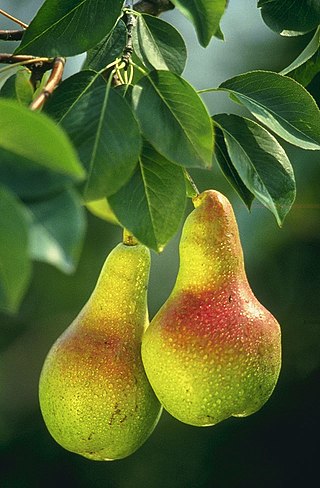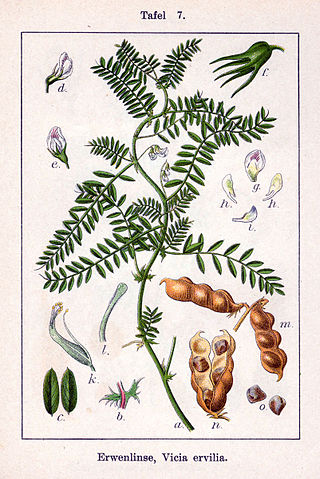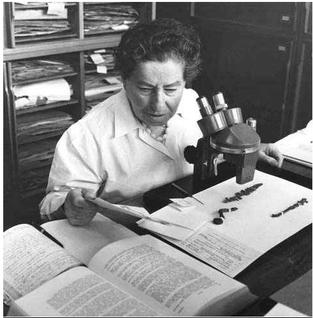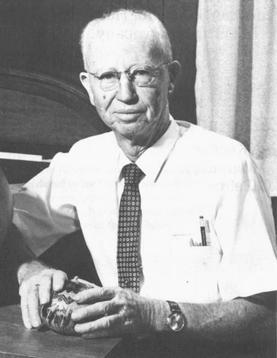Related Research Articles

Einkorn wheat can refer either to a wild species of wheat (Triticum) or to its domesticated form. The wild form is T. boeoticum, and the domesticated form is T. monococcum. Einkorn is a diploid species of hulled wheat, with tough glumes ('husks') that tightly enclose the grains. The cultivated form is similar to the wild, except that the ear stays intact when ripe and the seeds are larger. The domestic form is known as "petit épeautre" in French, "Einkorn" in German, "einkorn" or "littlespelt" in English, "piccolo farro" in Italian and "escanda menor" in Spanish. The name refers to the fact that each spikelet contains only one grain.

Emmer wheat or hulled wheat is a type of awned wheat. Emmer is a tetraploid. The domesticated types are Triticum turgidum subsp. dicoccum and T. t. conv. durum. The wild plant is called T. t. subsp. dicoccoides. The principal difference between the wild and the domestic forms is that the ripened seed head of the wild plant shatters and scatters the seed onto the ground, while in the domesticated emmer, the seed head remains intact, thus making it easier for people to harvest the grain.

The founder crops or primary domesticates are a group of flowering plants that were domesticated by early farming communities in Southwest Asia and went on to form the basis of agricultural economies across Eurasia. As originally defined by Daniel Zohary and Maria Hopf, they consisted of three cereals, four pulses, and flax. Subsequent research has indicated that many other species could be considered founder crops. These species were amongst the first domesticated plants in the world.

Pyrus communis, the common pear, is a species of pear native to central and eastern Europe, and western Asia.

The mustard plant is any one of several plant species in the genera Brassica, Rhamphospermum and Sinapis in the family Brassicaceae. Mustard seed is used as a spice. Grinding and mixing the seeds with water, vinegar, or other liquids creates the yellow condiment known as prepared mustard. The seeds can also be pressed to make mustard oil, and the edible leaves can be eaten as mustard greens. Many vegetables are cultivated varieties of mustard plants; domestication may have begun 6,000 years ago.

Vicia ervilia, called ervil or bitter vetch, is an ancient legume crop of the Mediterranean region. Besides the English names, other common names include: gavdaneh (Persian), kersannah (Arabic), yero (Spanish), rovi (Greek), and burçak (Turkish). The nutritional value of the grain for ruminant cattle has guaranteed the species' continued cultivation in Morocco, Spain and Turkey. The crop is easy to cultivate and harvest and can be grown on very shallow, alkaline soils.
Michael Zohary was a pioneering Israeli botanist.

Triticum timopheevii, Timopheev's wheat or Zanduri wheat, is a tetraploid wheat that has both cultivated and wild forms. It is believed to have evolved in isolation from the more common Triticum turgidum; hybrids between T. timopheevii and T. turgidum are reportedly sterile with "a considerable amount of chromosomal irregularities in meiosis."

Most of the food items which define modern North Indian and Subcontinental cooking have origins inside the Indian subcontinent though many foods that are now a part of them are based on fruits and vegetables that originated outside the Indian subcontinent.

Alexander Eig was a botanist, one of the first plant researchers in Israel, head of the department of Botany at the Hebrew University in Jerusalem and co-founder of the National Botanic Garden of Israel on Mount Scopus campus.

Avraham Fahn was an Israeli professor of botany at the Hebrew University of Jerusalem.

Barbara Pickersgill is a British botanist with a special interest in the domestication of crops, the genetics, taxonomy, and evolutionary biology of cultivated plants, and the preservation of crop diversity. Her 1966 dissertation for the degree of Doctor of Philosophy from Indiana University concerned the taxonomy of Capsicum chinense. Her doctoral advisor was Charles B. Heiser.

Naomi Feinbrun-Dothan was a Russian-born Israeli botanist, who became part of the academic staff at the Hebrew University of Jerusalem. She studied the flora of Israel and published dozens of articles and several analytical flora books. Just after her 91st birthday, she received the 1991 Israel Prize for her unique contribution to the Land of Israel studies.

Thomas Wallace Whitaker was an American botanist and horticulturist who spent most of his career working as a geneticist for the United States Department of Agriculture (USDA). He specialized in the study of economically important plants such as squashes, investigating their systematics and resistance to disease.
Chaya Clara Heyn was an Israeli botanist and professor at the Alexander Silberman Institute of Life Sciences, the Hebrew University of Jerusalem, also working in the university's herbarium. She has cataloged and identified many plants, and three taxa are named in her honor.

Mordechai E. Kislev is an Israeli emeritus professor in the Mina and Everard Goodman Faculty of Life Sciences at Bar-Ilan University, specializing in archaeological botany. Some of his prominent research focuses on prehistoric early agriculture and archaeological entomology. Other works explore the ancient landscape of the Land of Israel, as well as Torah and Science issues.

Charles Bixler Heiser Jr. (1920–2010) was a professor of botany, known as a leading expert on the sunflower genus Helianthus. He is also noteworthy as the author of a "series of popular books that did much to promote botany to the general public."

The Alexander Silberman Institute of Life Sciences (AS-ILS) at the Hebrew University of Jerusalem is the oldest life sciences research institute in Israel. It is part of the Faculty of Sciences, and is located in the Edmond J. Safra Campus in Jerusalem.
Ehud Zohary is an Israeli scientist, professor of neurobiology at the Edmond and Lilly Safra Center for Brain Science and Alexander Silberman Institute of Life Sciences, the Hebrew University of Jerusalem.
References
- ↑ Janick, Jules (2014-11-17). Plant Breeding Reviews, Volume 38. John Wiley & Sons. pp. 3–11. ISBN 978-1-118-91683-4.
- ↑ Zohary, Daniel; Hopf, Maria; Weis, Ehud (March 2012). Domestication of Plants in the Old World: The origin and spread of domesticated plants in Southwest Asia, Europe, and the Mediterranean Basin. Oxford University Press. ISBN 9780199549061.
- 1 2 3 Rottenberg, Aaron (2017-08-01). "Daniel Zohary (1926–2016)". Genetic Resources and Crop Evolution. 64 (6): 1101–1106. doi:10.1007/s10722-017-0530-4. ISSN 1573-5109. S2CID 31768357.
- 1 2 Daniel Zohary - Curriculum Vitae
- ↑ "Tamar Zohary, Google Scholar".
- ↑ "Ruth Shouval Zohary".
- ↑ International Plant Names Index. D.Zohary.
- ↑ "Society for Economic Botany | Distinguished Economic Botanists". oldsite.econbot.org. Retrieved 2024-05-15.